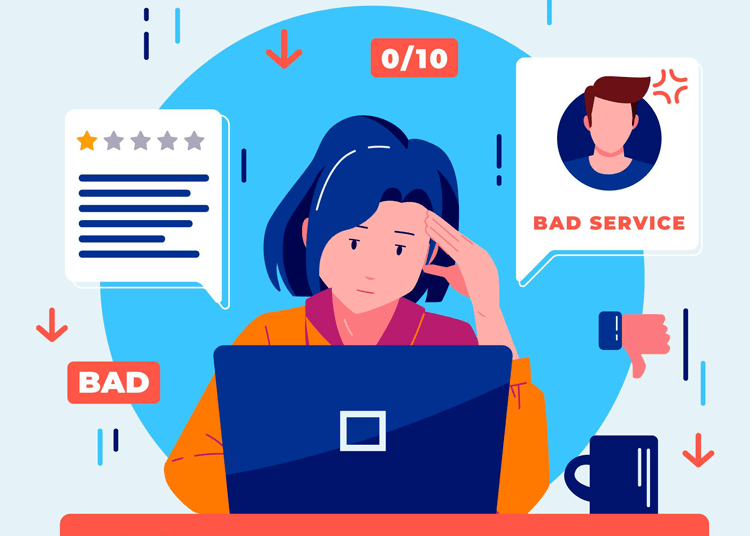10 Examples of Bad Customer Service and How to Fix Them
Bad customer service can harm a company’s reputation, making customers unhappy and unwilling to do business with them again. In this post, we’ll discuss 10 common examples of bad customer service and why they’re problematic.
We’ll also suggest how customer service representatives can improve these situations for a better customer experience. Knowing where customer service often goes wrong and how to fix it can help your brand keep customers and maintain a positive reputation.
Support Genix
WordPress Support Ticket Plugin
Take Your Customer Support to The Next Level and Boost Customer Satisfaction Rates
What is Bad Customer Service?
Bad customer service occurs when the service delivered falls short of customer expectations. This often leads to negative feelings towards the business. It also happens happenin different ways, like having unfriendly staff, long wait times, or broken promises.

Bad customer service isn’t just experienced in person. It can also occur online or during phone interactions. Such experiences can leave a lasting bad impression on customers, making them less likely to return. To succeed, businesses must give great customer service to build positive relationships.
Impact of Poor Customer Service on Businesses and Consumers
Key Impacts of Poor Customer Services are given below:
- Loss of Customers: Businesses can lose a lot of customers due to bad customer service. Negative experiences spread fast online, harming customer loyalty.
- Decreased Revenue: Negative customer experiences often lead to a decrease in repeat purchases. This can directly impact a business’s profitability and impede its growth.
- Damaged Reputation: In the digital age, a single negative review can quickly tarnish a business’s reputation, deterring potential customers from engaging with it.
- Lost Opportunities: Poor customer service hampers meaningful interactions, limiting feedback, suggestions, and the ability to develop long-term customer relationships.
- Decreased Customer Satisfaction: Customers who don’t feel valued are likely to explore other options. They may switch to competitors that provide better service, thus deepening their dissatisfaction.
Recommended Blog for You:
👉 What Is a Customer Journey Map and Why You Need One?
👉 8 Best WordPress Ticket System Plugins: A Comprehensive Overview
👉 Top 6 WordPress Help Desk Plugins to Streamline Your Support Process
👉 What is Email Piping and How to Get it Running on SupportGenix: A Complete Guide
👉 Customer Support for Startups: Why Customer Support Should Be a Priority for Startups
Importance of Good Customer Service
The importance of good customer service is given below:
- Good customer service retains customers by offering a positive and valued experience.
- Exceptional service builds loyalty, encouraging repeat purchases and recommendations.
- Excellent customer service reinforces a positive brand image, fostering a good reputation.
- Effective service converts potential customers into buyers, driving revenue growth.
- Good service ensures customers feel supported and satisfied, contributing to overall happiness.
- This type of customer service builds trust, fostering loyalty and a stronger connection with the brand.
- Outstanding services set a business apart, attracting customers who value superior support.
- Excellent service maximizes the lifetime value of customers, leading to more frequent and valuable purchases.
10 Examples of Bad Customer Service
Long Wait Times
When it comes to bad customer service, one of the most common problems customers face is long wait times. It’s frustrating to be placed on hold for an extended period only to be transferred to another representative who offers no solution. Long wait times waste your time and indicate that a company needs to prioritize customer satisfaction.
How to Fix Long Wait Times
- Increase staffing during peak hours.
- Implement an efficient queuing system.
- Offer online alternatives or self-service options.
- Communicate wait times clearly to manage expectations.
- Regularly assess and optimize staffing levels.
Lack of Empathy
When customer service representatives lack empathy, customers feel unimportant and unheard. This often results in dissatisfaction and a negative perception of the company.
How to Improve Lack of Empathy
- Train customer service team in empathy skills.
- Encourage active listening to understand customers’ emotions.
- Foster a customer-centric culture within the organization.
- Provide regular feedback and coaching to enhance empathy.
- Share positive customer stories that highlight empathetic interactions.
Rude or Unprofessional Behavior
Customers experience dissatisfaction when confronted with rude or unprofessional behavior from customer service representatives. This can include disrespectful language, dismissive attitudes, or unhelpful demeanor.
How to Improve Rude and Unprofessional Behavior
- Create training programs that highlight the significance of professional behavior and effective communication.
- Set clear guidelines for respectful interactions, especially in customer service.
- Monitor and evaluate customer interactions regularly to identify areas for improvement.
- Provide conflict resolution skills to handle challenging situations calmly and professionally.
- Recognize and reward exemplary customer service to promote a culture of professionalism.
Inaccurate or Misleading Information
Inaccurate or misleading information frustrates customers and can harm a business’s reputation. There’s nothing more frustrating than receiving the wrong information as a customer. It can lead to wasted time, frustration, and, ultimately, a loss of trust in the company.
How to Ensure Accurate Information
- Provide comprehensive and ongoing training to ensure a deep understanding of products, services, and policies.
- Preserve an up-to-date resource with accurate information about products, services, and common issues.
- Review and update information regularly to inform customer service reps about any changes.
- Establish a system for reps to report inaccuracies encountered, using the feedback to make improvements.
- Implement tools like CRM systems to help reps access accurate information quickly.
Causes of Difficulty in Issue Resolution
Dealing with bad customer service can sometimes feel like a nightmare, especially when resolving an issue. Various causes contribute to difficulty in issue resolution, such as lack of communication, insufficient training, and an unhelpful attitude from the customer service representative.
Improving Issue Resolution Processes
- Train customer service reps well to handle customer issues effectively.
- Improve communication between departments for a smoother resolution process.
- Give reps the tools and authority to resolve customer problems quickly.
- Use modern technology for efficient issue tracking and resolution.
- Get customer feedback to improve issue resolution continuously.
Reasons for Ignoring Customer Feedback
One of the most frustrating experiences as a customer is feeling ignored when you try to give feedback. It can leave you feeling like your opinion doesn’t matter, or the company doesn’t care about improving its service. Unfortunately, there are many reasons why customer feedback might be ignored, such as a lack of resources, misunderstandings about the importance of feedback, or simply a lack of empathy towards the customer.
How to Act on Customer Feedback
- Provide accessible and user-friendly channels for customers to share their feedback.
- Consistently monitor and analyze customer feedback to identify trends and common issues.
- Show appreciation for customer input, even if it is negative, and acknowledge the concerns raised.
- Focus on addressing feedback that can lead to meaningful improvements in products or services.
- Keep customers informed about the changes made due to their feedback, fostering transparency.
Causes of Lack of Personalization
When it comes to customer service, personalization can make all the difference. However, one of the main causes of poor customer service is a lack of personalization. Customers want to feel heard and seen as individuals, not just another number in the system. When companies fail to make an effort to personalize interactions with their customers, this can leave them feeling frustrated and undervalued.
Implementing Personalization in Customer Service
- Gather detailed and relevant customer information for effective personalization.
- Provide ongoing training to customer service representatives on personalization strategies.
- Coordinate and unify communication channels for consistent personalization.
- Clearly communicate privacy policies to build trust while collecting customer data.
- Utilize robust analytics tools to analyze customer data for accurate personalization efforts.
Creating Problems Instead of Solving Them
When it comes to customer service, people want helpful and quick solutions. But what if the customer service representative ends up causing more problems instead of fixing them? This kind of service can make customers feel frustrated, angry, and let down.
How to Improve Customer Service by Focusing on Solutions:
- Make sure your team focuses on solving issues instead of making more problems.
- Give your team the authority to make quick decisions to solve problems without worsening them.
- Promote positive and solution-oriented communication with customers for a better experience.
- Make policies and procedures clear so that reps can offer effective solutions easily.
- Recognize and reward employees who consistently do well in solving customer problems, promoting a customer-focused mindset.
Using jargon or technical terms
When it comes to customer service, clear communication is key. Unfortunately, many companies make the mistake of using excessive jargon or technical terms when interacting with customers. Not everyone is familiar with industry-specific language, and confusing your customers with unfamiliar terminology leads to frustration and annoyance.
Simplify Communication:
- Use simple and straightforward words instead of technical jargon.
- Opt for terms customers can easily understand without specialized knowledge.
- Steer clear of using acronyms unless specific customers are familiar with them.
- If technical terms are necessary, provide clear explanations to ensure customer comprehension.
- Use language that shows an understanding of the customer’s perspective, avoiding language that may sound dismissive.
Ignoring feedback
In business, ignoring customer feedback can be harmful. Poor customer service, especially not paying attention to reviews and comments, can quickly give your business a bad reputation. Nowadays, it’s easy for customers to share their opinions online, and these reviews are visible to everyone with just a few clicks.
Actively Seek and Respond to Feedback:
- Offer various ways (like surveys, social media, and customer reviews) for customers to share their thoughts and experiences.
- Do frequent surveys to collect feedback on your products or services.
- Quickly respond to customer feedback, addressing concerns and recognizing positive comments.
- Publicly recognize positive feedback to show gratitude for customer support.
- Openly communicate about changes made based on customer feedback, building trust and transparency.
Support Genix
WordPress Support Ticket Plugin
Take Your Customer Support to The Next Level and Boost Customer Satisfaction Rates
Frequently Asked Questions
Is unresponsive customer support a common problem?
Yes, unresponsive customer support is a significant issue that can frustrate customers. To fix this, implement efficient systems for responding to customer inquiries promptly and ensure support staff are adequately trained.
Can lack of personalization in email marketing campaigns impact customer service?
Absolutely! Lack of personalization in email marketing can make customers feel like they are receiving generic messages. To fix this, businesses should segment their email lists and personalize the content based on customer preferences and behaviors.
Is a complicated checkout process considered bad customer service in online stores?
Yes, a complicated checkout process can frustrate customers and result in abandoned carts. To fix this, online stores should simplify their checkout process by minimizing steps, offering guest checkout options, and providing multiple payment methods.
Final Word
Bad customer service can hurt a business and its reputation. The 10 examples of bad customer service we talked about show that things like not communicating well, not being understanding, and not taking responsibility are common mistakes. But here’s the good news: we can fix these mistakes by improving customer service.
If we listen to what customers say, we can understand their concerns and problems. By taking responsibility for these issues and improving our communication, we can turn unhappy customers into loyal supporters of our business. Good customer service is super important because it can be the thing that makes customers choose our company over others.


